
Phar Lap was a champion Australasian Thoroughbred racehorse. Achieving incredible success during his distinguished career, his initial underdog status gave people hope during the early years of the Great Depression. He won the Melbourne Cup, two Cox Plates, the Australian Derby, and 19 other weight-for-age races.

Lord Howe Island is an irregularly crescent-shaped volcanic remnant in the Tasman Sea between Australia and New Zealand, part of the Australian state of New South Wales. It lies 600 km (320 nmi) directly east of mainland Port Macquarie, 780 km (420 nmi) northeast of Sydney, and about 900 km (490 nmi) southwest of Norfolk Island. It is about 10 km (6.2 mi) long and between 0.3 and 2.0 km wide with an area of 14.55 km2, though just 3.98 km2 of that comprise the low-lying developed part of the island.

Kenneth George Hall was an Australian film producer and director, considered one of the most important figures in the history of the Australian film industry. He was the first Australian to win an Academy Award.

Cinesound Productions Pty Ltd was an Australian feature film production company. Established in June 1931, Cinesound developed out of a group of companies centred on Greater Union Theatres that covered all facets of the film process, from production to distribution and exhibition.

Shirley Ann Richards was an Australian actress and author who achieved notability in a series of 1930s Australian films for Ken G. Hall before moving to the United States, where she continued her career as a film actress, mainly as a Metro-Goldwyn-Mayer starlet. Her best known performances were in It Isn't Done (1937), Dad and Dave Come to Town (1938), An American Romance (1944), and Sorry, Wrong Number (1948). In the 1930s, she was the only Australian actor under a long-term contract to a film studio, Cinesound Productions. She subsequently became a lecturer and poet.

Malcolm R. Afford known as Max Afford, was an Australian playwright and novelist.

Mr. Chedworth Steps Out is a 1939 Australian comedy film directed by Ken G. Hall starring Cecil Kellaway. Kellaway returned to Australia from Hollywood to make the film, which features an early screen appearance by Peter Finch.
Edmond Seward was a Hollywood screenwriter who had originally attended Northwestern University and worked as a journalist, before doing some writing for Disney.

Thoroughbred is a 1936 Australian race-horse drama film directed by Ken G. Hall, partly based on the life and career of Phar Lap. Hollywood star Helen Twelvetrees was imported to Australia to appear in the film. The film also stars Frank Leighton and John Longden.

Orphan of the Wilderness is a 1936 Australian feature film from director Ken G. Hall about the adventures of a boxing kangaroo. It starred Brian Abbot who disappeared at sea not long after filming completed.
It Isn't Done is a 1937 Australian comedy film about a grazier who inherits a barony in England.

Lovers and Luggers is a 1937 Australian film directed by Ken G. Hall. It is an adventure melodrama about a pianist who goes to Thursday Island to retrieve a valuable pearl.
Tall Timbers is a 1937 action melodrama set in the timber industry directed by Ken G. Hall and starring Frank Leighton and Shirley Ann Richards.

Mystery Island is a 1937 Australian film shot almost entirely on location near Lord Howe Island. It is best remembered for the mysterious disappearance of two of its cast after filming completed.
Gwendolyn Mina Munro was an Australian actress best known for playing the female lead in Orphan of the Wilderness (1936).
Frank Leighton (1908–1962) was an Australian actor best known for two leading roles in films for Ken G. Hall, Thoroughbred (1936) and Tall Timbers (1937).
When the Kellys Rode is a 1934 Australian film directed by Harry Southwell about Ned Kelly.
George Heath was an Australian cinematographer best known for his collaboration with Ken G. Hall for whom he shot several features. According to one observer, he fitted into the Cinesound world far more than his predecessor, Frank Harley - "Heath adapted much more easily to studio work and soon developed into a technician of world class. His work on the features was always attuned to the demands of the film and its future audience: his images show few of the pretensions to grandeur which are to be found in the work of Hurley, and instead his photography is clear, expressive and undemanding."
Rosemary Edna Sinclair is an Australian activist and beauty pageant titleholder. She is involved in administrative approach related to developmental actions. She won the title of Miss Australia in 1960.
Ronald Whelan was an Australian actor, assistant director and unit manager. He was the son of actor Albert Whelan.












